Anyone can use a long tail keyword finder in order to find keywords for their blog posts. I use Google’s own keyword planner which is a free tool. All you need is an Adwords account to use it.
Many bloggers target long tail keywords with their articles because there’s a greater chance they can rank their content for them. Shorter phrases tend to be much more competitive.
Here’s how to use Google’s free keyword planner to find those long tail keywords and how to check their relative competition against other content.
Long Tail Keyword Finder – Google’s Keyword Planner
Sign in to your Adwords account and click on the “tools and settings” tab in the top right hand side of your dashboard. If you have an account you should find the keyword planner here.

Click on the keyword planner tab in the left had column (see below)
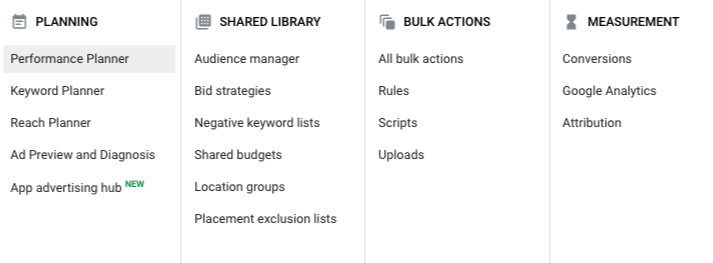
Next type your main “seed” keyword into Google’s Keyword Planner. You should be offered a number of keywords which are being searched for on Google. Usually you’ll be shown the most competitive keywords first, in order of the most monthly searches. So, if your main keyword was “buy shoe laces” you would type that keyword into the planner and see what comes up. You’ll see the most competitive keywords which relate to your “seed” keyword come up first.
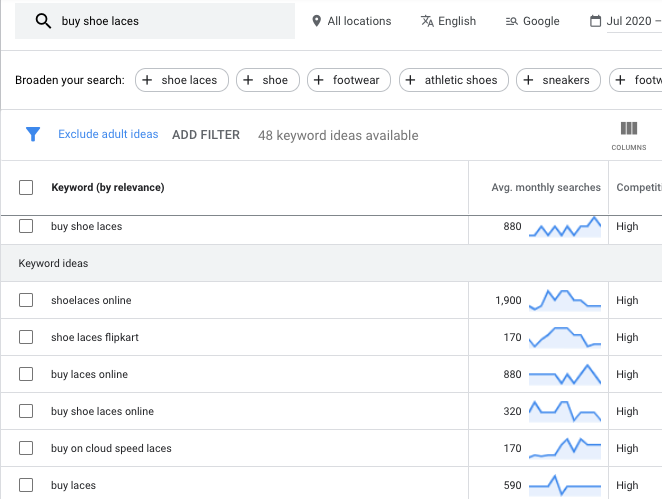
Click on the Avg. monthly searches tab above the search results number column. This will tab/scroll the average monthly searches from most to least. Keep clicking it until you see the lowest monthly searched in the column. It should show between 10 and 30 monthly searches in each row (see below).
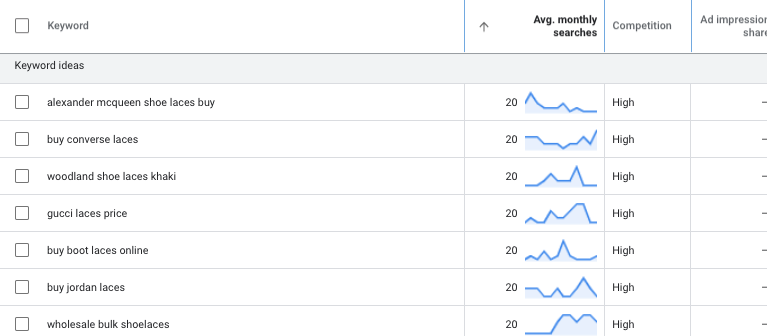
Scroll down to the bottom of the chart and you’ll see the scroll bar. Click on the right arrow and you can then scroll through the search results in order of least searched for keywords towards the most searched for results. As you do so, you should find the long tail keywords which offer the least competition in the search results.
Long Tail Keyword Finder – Finding Those Keywords With Less Competition
As you scroll through the keywords which have fewer monthly searches you should see some nice long tail keywords. Ideally we want to find long tail keywords with low SEO difficulty. To determine this we can type the keyword we choose into Google to see the relative competition. We’ll use the example of “lazy elastic shoelaces” from the above “buy shoe lace” keyword example. “Lazy elastic shoelaces” has 170 monthly searches (according to the planner).

Once we find a long tail keyword (3 or more keywords) which we want to target with our content, we can head over the Google and type it in. Type it into Google to see results using both open search and phrase match (using “” quotation marks around your keywords). You should see a number come up while doing this at the top of the screen underneath the search bar.
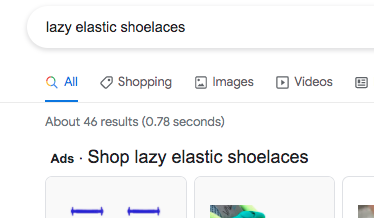
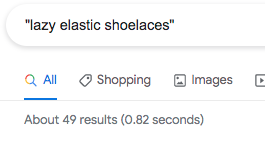
These numbers should give you an idea about how competitive your keyword phrase is. You can also look at the results under the open match to see the competing websites for your particular search query. If there’s a number of high level domains ranking for your search term, it might be tough to rank for it. However, if you see videos and question and answer sites, it might be easier to rank.
Example
Here’s a video using the example seed keyword “yoga mat”. As you can see, there’s lots of long tail keywords which appear using this search.
Ideally find the keywords which offer the least competition during a Google search. This can take some time and research, and the more you do it, and create content for the keywords you find, the more you’ll know.
Of course some of your content will rank and much of it won’t, depending on the keywords you choose. But over time, you should get to know which keywords are more likely to offer you the best opportunity of free traffic.
Creating Content
Once you find a good long tail keyword which offer the least amount of competition on Google, it’s time to write a good quality article. Ideally use a good SEO (search engine optimisation) plugin to help you write search engine friendly content. See best free blog plugins for WordPress.
Write at least 1000 words to give you the best chance of ranking your content. You can also find share plugins to help you syndicate your content throughout social media in the link above.
Keep creating content and putting it out there! Over time, some if it will find its way to the top of the search queries. Even if you don’t manage to rank on Google, don’t forget your content will rank on Bing, Yahoo, Duckduckgo and other search engines. So it’s worth putting the effort in and sticking to a good consistent blogging plan.
For more on this strategy download my free ebook “Niche Blogging For Profit“.
